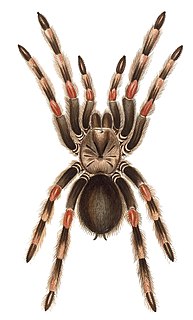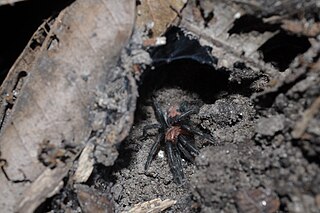Related Research Articles

Brachypelma is a genus of spiders in the family Theraphosidae (tarantulas). They may have bodies up to 6 cm long with legs of similar or greater lengths. Some species have brightly colored legs, with red or orange marks and rings.

Brachypelma smithi is a species of spider in the family Theraphosidae (tarantulas) native to Mexico. It has been confused with Brachypelma hamorii; both have been called Mexican redknee tarantulas. Mexican redknee tarantulas are a popular choice as pets among tarantula keepers. Many earlier sources referring to B. smithi either relate to B. hamorii or do not distinguish between the two species. B. smithi is a terrestrial tarantula native to Pacific coast of the Mexican state of Guerrero.

Tetrablemmidae, sometimes called armored spiders, is a family of tropical araneomorph spiders first described by Octavius Pickard-Cambridge in 1873. It contains 126 described species in 29 genera from southeast Asia, with a few that occur in Africa and Central and South America. Pacullidae was incorporated into this family in 1981, but was later restored as a separate family in a 2016 phylogenetic study.
Acanthopelma is a genus of tarantulas that was first described by Frederick Octavius Pickard-Cambridge in 1897. As of December 2019 it contains two species, found in Central America and South America: A. beccarii and A. rufescens.

Acanthoscurria theraphosoides is a species of spider from the family Theraphosidae (tarantulas), found in Peru, Bolivia, Brazil, and French Guiana.

Tarantulas comprise a group of large and often hairy spiders of the family Theraphosidae. Currently, 1,010 species have been identified. The term "tarantula" is usually used to describe members of the family Theraphosidae, although many other members of the same infraorder (Mygalomorphae) are commonly referred to as "tarantulas" or "false tarantulas". Some of the more common species have become popular in the exotic pet trade. Many New World species kept as pets have setae known as urticating hairs that can cause irritation to the skin, and in extreme cases, cause damage to the eyes.

Coneweb spiders (Diguetidae) are six-eyed haplogyne spiders that live in tangled space webs, fashioning a cone-like central retreat where they hide and lay eggs. It is a small family, containing only two genera with fifteen species and is confined to the New World, preferring deserts. Members of the genus Diguetia usually build their webs in shrubs or between cactus pads. They have the same eye arrangement as the venomous recluse spiders, but none are known to be harmful to humans.

The skeleton tarantula, Ephebopus murinus, is a species of spider belonging to the family Theraphosidae (tarantulas), sub-family Aviculariinae. A New World species, it is native to several South American countries. Its common name is derived from the skeleton-like markings on its legs.

Brachypelma albiceps is a species of spider in the tarantula family, Theraphosidae. It is known as the Mexican golden red rump tarantula or the Amula red rump tarantula. The carapace is a light golden color and the abdomen dark, covered with long red hairs. Females typically live for about 15 years. Males usually live about 5 years or up to 12 months after the last molt.
Atypoides is a genus of North American folding trapdoor spiders. It was first described by Octavius Pickard-Cambridge in 1883, and it has only been found in United States. It was synonymized with the genus Antrodiaetus in 2007, but was restored to its former independent status in 2019. As of November 2021 it contains only three species: A. gertschi, A. hadros, and A. riversi.

Davus pentaloris is a species of New World tarantula native to Mexico and Guatemala. Davus was at one time considered to be a synonym of Cyclosternum, and its species were placed in that genus, but this is no longer accepted.

The Theraphosinae are a large subfamily of Mygalomorphae spiders in the family Theraphosidae found in the Neotropical realm.

Citharacanthus is a genus of New World tarantulas. They are found in Central America and the Antilles.

Davus, also known as the tiger rump tarantulas, is a genus of spiders in the family Theraphosidae (tarantulas). It was formerly included in Cyclosternum.
Anisaspoides is a monotypic genus of Brazilian baldlegged spiders containing the single species, Anisaspoides gigantea. It was first described by Frederick Octavius Pickard-Cambridge in 1896, and is only found in Brazil.

Avicularia variegata is a species of spider in the family Theraphosidae found in Venezuela and Brazil. Previously described as Avicularia avicularia variegata, it is synonymous with Avicularia bicegoi.
Harmonicon is a genus of South American curtain web spiders that was first described by F. O. Pickard-Cambridge in 1896.

Tliltocatl is a genus of North American tarantulas that was split off from Brachypelma in 2020. They are also large burrowing tarantulas, but don't have the striking red leg markings of Brachypelma species. A female T. vagans can grow up to 50 mm (2.0 in) long and legs can get as long as 55 mm (2.2 in). They are found predominantly in Mexico, with some species native to Central America. The name is derived from two Nahuatl words, "tlil", meaning "black", and "tocatl", meaning "spider". Habitat destruction and collection for the pet trade has led to this and Brachypelma to be protected under International Convention on International Trade of Endangered Species rules, beginning with B. smithi.

Hapalopus coloratus is a species of tarantula found in Panama. It was first described by Carlos E. Valerio in 1982 as Metriopelma coloratum. It was transferred to the genus Hapalopus in 2016.
Spinosatibiapalpus is a genus of tarantulas erected by Gabriel and Sherwood in 2020 for a newly discovered species and two other previously described species bearing a unique palpal bulb morphology. The name is a reference to the spines found on the fourth section of the pedipalp in adult males. This distinctive feature was also found in Pseudhapalopus species, but because it is never mentioned in the original description of that genus, Gabriel and Sherwood called into question the validity of Pseudohapalopus, and moved all its species except P. aculeatus, known only from a single male found in Bolivia in 1907. It is impossible to place P. aculeatus because the holotype was destroyed when the museum housing it was bombed during World War II, and it has been declared as nomen dubium.
References
- ↑ Gabriel, R. (2016), "Revised taxonomic placement of the species in the Central American genera Davus O. Pickard-Cambridge, 1892, Metriopelma Becker, 1878, and Schizopelma F. O. Pickard-Cambridge, 1897, with comments on species in related genera (Araneae: Theraphosidae)", Arachnology, 17 (2): 61–92, doi:10.13156/arac.2006.17.2.61, S2CID 88749325
- ↑ "Gen. Eurypelma Strand, 1907", World Spider Catalog, Natural History Museum Bern, retrieved 2020-07-25